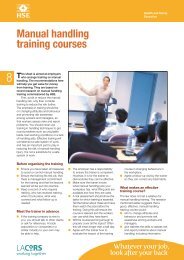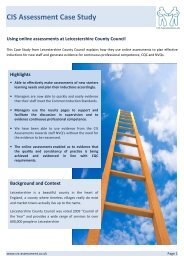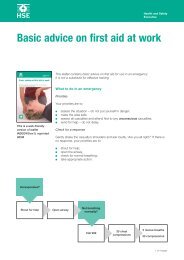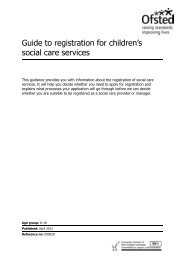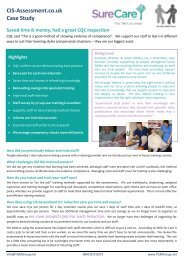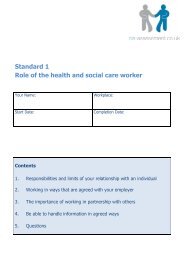Standard 8 Health and safety in an adult social care setting
Standard 8 Health and safety in an adult social care setting
Standard 8 Health and safety in an adult social care setting
You also want an ePaper? Increase the reach of your titles
YUMPU automatically turns print PDFs into web optimized ePapers that Google loves.
The grim truth about food poison<strong>in</strong>g<br />
CIS Assessment Induction Workbook – Eight<br />
There are millions of cases of food poison<strong>in</strong>g every year <strong>in</strong> the UK<br />
Food poison<strong>in</strong>g occurs when people eat food that has been contam<strong>in</strong>ated with<br />
harmful germs (particularly bacteria <strong><strong>an</strong>d</strong> viruses) or tox<strong>in</strong>s (poisonous subst<strong>an</strong>ces).<br />
Bacteria need warmth <strong><strong>an</strong>d</strong> moisture to grow. They reproduce by divid<strong>in</strong>g themselves, so<br />
one bacterium becomes two <strong><strong>an</strong>d</strong> then two become four <strong><strong>an</strong>d</strong> so on. In the right conditions<br />
one bacterium could become several million <strong>in</strong> 8 hours <strong><strong>an</strong>d</strong> thous<strong><strong>an</strong>d</strong>s of millions <strong>in</strong> 12<br />
hours.<br />
This me<strong>an</strong>s that if a food is contam<strong>in</strong>ated with a small number of bacteria <strong><strong>an</strong>d</strong><br />
you leave it out of the fridge overnight it could be seriously contam<strong>in</strong>ated by<br />
the next day. Then just one mouthful could make someone ill. If you put food <strong>in</strong> the<br />
fridge it will stop bacteria from multiply<strong>in</strong>g.<br />
S<strong>in</strong>ce you c<strong>an</strong>’t see, taste or smell bacteria, the only way that you c<strong>an</strong> be sure that food is<br />
safe is to follow good hygiene at all times.<br />
Harmful bacteria c<strong>an</strong> be found <strong>in</strong> hum<strong>an</strong>s, for example, eyes, nose, throat, stomach, sk<strong>in</strong><br />
<strong><strong>an</strong>d</strong> mouth. It c<strong>an</strong> also be found <strong>in</strong> raw eggs, pets, soil, dust <strong><strong>an</strong>d</strong> dirt.<br />
Chill<strong>in</strong>g<br />
Some foods need to be kept chilled to keep them safe, for example food with a ‘Use by’ date,<br />
food that you have cooked <strong><strong>an</strong>d</strong> won’t serve immediately or other ready-to-eat food such as<br />
prepared salads.<br />
If these foods are not properly chilled, bacteria c<strong>an</strong> grow <strong><strong>an</strong>d</strong><br />
make people ill. Freezers need to be kept between -22 to -<br />
18°C <strong><strong>an</strong>d</strong> fridges need to be kept between 0-5° C.<br />
Cross-Contam<strong>in</strong>ation<br />
Cross-contam<strong>in</strong>ation is when bacteria spread between food, surfaces or equipment. It's most<br />
likely to happen when:<br />
Raw meat should be stored<br />
at the bottom of the fridge.<br />
Raw <strong><strong>an</strong>d</strong> cooked meals <strong><strong>an</strong>d</strong><br />
meats should not be stored<br />
on the same shelf<br />
Hot food must never<br />
be put <strong>in</strong> the fridge<br />
raw food touches (or drips onto) other food<br />
raw food touches (or drips onto) equipment or<br />
surfaces<br />
people touch raw food with their h<strong><strong>an</strong>d</strong>s<br />
If raw meat drips onto a cake <strong>in</strong> the fridge, bacteria will spread from the meat to the cake.<br />
Page 27 of 46



